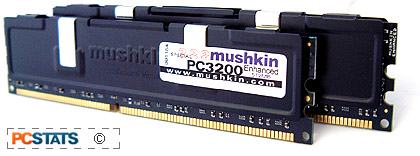To start things off, we plugged in the Mushkin Enhanced Special
PC3200 2-2-2 DIMM's into the Athlon64 test system. After lowering the multiplier to
8x and setting the timings to 2-2-2-5, I slowly began to raise the clock speed
of the motherboard. At around 207 MHz there were
a few stability problems, but that was fixed by raising the memory voltage to
2.7V. We continued to push the Mushkin RAM further, and at 215 MHz we had to
raise voltage to 2.8V.
 With that voltage we were able to push the motherboard
FSB of the Athlon64 system to 227 MHz! Anything higher and stability would be compromised.
Still, 227 MHz with 2.8V is definitely very good.
With that voltage we were able to push the motherboard
FSB of the Athlon64 system to 227 MHz! Anything higher and stability would be compromised.
Still, 227 MHz with 2.8V is definitely very good.
With the
Athlon 64 system out of the way, the Mushkin Enhanced
Special PC3200 2-2-2 DIMM's were dropped into an ABIT IC7-MAX3 motherboard, and
the FSB cranked up. At 217 MHz FSB, the board showed
some stability problems, but that was fixed by raising the DIMM
voltage to 2.8V. Ultimately, the Mushkin memory rose
to the occasion, reaching 236MHz FSB.
Just for fun I wanted to see how high the
Mushkin Enhanced Special PC3200 2-2-2 memory would go with higher voltages; at 3.5V it reached 255
MHz with 2-2-2-5 timings. According to a Fluke 50S thermometer, the heat spreader temps
reached 54 degrees Celsius here... so this is not an advisable setting
if you value longevity of your memory.
All benchmarks were run at 236 MHz FSB. That is the
highest speed the Mushkin Enhanced Special PC3200 2-2-2 DIMMs would run with a voltage of 2.8V, which is the maximum
safe voltage for most motherboards.
Memory Test Methodology
PCstats tests DDR memory on two major CPU platforms - the AMD Athlon64 and the Intel Pentium 4 - because RAM behaves differently with each processor architecture. For instance, Intel users tend to run their memory at high speeds with high latency settings, and in general that works quite well for Intel-based computers. It would be detrimental to system performance
if you were to run the same DDR memory settings on an AMD Athlon64 system, since latency plays a much larger role in system performance. Because much of our audience is made up of enthusiasts, PCstats also runs overclocking tests so you can get an idea on how far the memory will go.
On both
Intel and AMD test PCs, we're only interested in seeing how high we can go with the memory running 1:1, as running with other dividers puts the overclocking bottleneck elsewhere, and not
with the system memory. On the Pentium 4 test system we sometimes use higher latencies in our tests, as latencies are not as important. With the AMD Athlon64 test system, the DDR RAM latency must run at 2-2-2-5, or the memory's tightest possible timings, as quick access is more important to the CPU design.
 |
| PCStats Test System #1 Specs: |
| processor: |
amd athlon64 3200+ |
| clock
speed: |
10 x 200 mhz = 2 ghz
9 x 227 mhz = 2.04 ghz |
| motherboards: |
asus k8v-dlx |
| videocard: |
ati radeon 9800xt |
| memory: |
2x 512mb corsair twinx 4000*
2x 512mb ocz pc3200
plat ltd ed.
2x 512mb mushkin pc3200 special ed. |
| hard drive:
|
40gb western digital special ed |
| cdrom: |
nec 52x cd-rom |
| powersupply: |
vantec 400b ion |
| software
setup |
windowsxp build 2600
via 4in1 4.51
catalyst 3.9 |
| workstation
benchmarks |
sisoft sandra
2003
pcmark2002
pcmark04
3dmark2001se
ut2003 | |
* - memory was running 3-4-4-8
 |
| PCStats Test System #2 Specs: |
| processor: |
intel pentium 4 2.4c |
| clock
speed: |
12 x 200 mhz = 2.4 ghz
12 x 236 mhz = 2.83 ghz |
| motherboards: |
abit ic7-max3 |
| videocard: |
ati radeon 9800xt |
| memory: |
2x 512mb corsair twinx 4000*
2x 512mb ocz pc3200
plat ltd ed.
2x 512mb mushkin pc3200 special ed. |
| hard drive:
|
40gb western digital special ed |
| cdrom: |
nec 52x cd-rom |
| powersupply: |
vantec 400b ion |
| software
setup |
windowsxp build 2600
via 4in1 4.51
catalyst 3.9 |
| workstation
benchmarks |
sisoft sandra
2003
pcmark2002
pcmark04
3dmark2001se
ut2003 | |
* - memory was running 3-4-4-8
